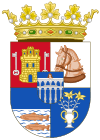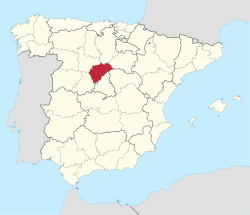Province of Segovia
Segovia (Spanish pronunciation: [seˈɣoβja] (![]()
Segovia | |
|---|---|
 Flag  Coat of arms | |
 Map of Spain with Segovia highlighted | |
| Coordinates: 41°10′N 4°00′W | |
| Country | Spain |
| Autonomous community | |
| Capital | Segovia |
| Area | |
| • Total | 6,920.65 km2 (2,672.08 sq mi) |
| Area rank | Ranked 37th |
| 1.35% of Spain | |
| Population (2012) | |
| • Total | 163,701 |
| • Rank | Ranked 48th |
| • Density | 24/km2 (61/sq mi) |
| 0.35% of Spain | |
| Demonym(s) | Spanish: Segoviano/a |
| Official language(s) | Spanish |
| Parliament | Cortes Generales |
| Website | Official website |
Overview
The province has a population of 149,286, of whom about 35% live in the capital, Segovia. Of the 209 municipalities in the province,[2] more than half are villages with under 200 people.
The origin of the name Segovia is said of Celtiberian origin, but also thought it was derived from the Visigoth conquest and occupation of Castile by the Goths, a Scandinavian / Germanic tribe lived in Castile from the 4th to 6th centuries AD.[3] The provincial corporation consists of 25 elected members. After the recent elections there are 10 members of the Spanish Socialist Workers Party and 15 of the People's Party. The historical heritage of this province is rich and varied. The capital city has the 800-metre-long Roman Aqueduct of Segovia, which is unique to the province. The capital was declared a world heritage site in 1985.[1] Sepúlveda, Ayllón, Pedraza, Coca and La Granja de San Ildefonso villages attract a large number of tourists.[1] La Granja de San Ildefonso houses a national monument–The Royal Palace. Antonio Machado's house is located in Ayllón.[1] Tourism is one of the most important industries. In July 2014, the provincial government signed an agreement with Bankia. Bankia will contribute 10,000 euros to promote the province's tourism industry.[4] Agriculture also has a significant contribution in the province's Gross Domestic Product. Wheat, barley, rye and rice have been the most important cereals.[5] During the seventeenth century many of the province's towns recorded decline in cereal production.[6] Cattle rearing is also an important commercial activity.[7]
See also
Notes and references
- "Province of Segovia". Euroresidentes. Retrieved 30 September 2014.
- (in Spanish) List of municipalities on provincial official website Archived 2016-03-05 at the Wayback Machine
- Altschul, Nadia R. (2012). Geographies of Philological Knowledge: Postcoloniality and the Transatlantic National Epic. University of Chicago Press. p. 105. ISBN 978-0-226-01619-1.
- "Bankia and the Provincial Government of Segovia sign an agreement to support tourism in the province". Bankia.com. 29 July 2014. Retrieved 30 September 2014.
- Commission, United States Centennial (1876). Official Catalogue: Complete in One Volume. I. Main Building. II. Department of Art. III. Department of Machinery. IV. Departments of Agriculture and Horticulture. Centennial catalogue Company. p. 4.
- Thompson, I. A. A.; Casalilla, Bartolomi Yun (1994). The Castilian Crisis of the Seventeenth Century: New Perspectives on the Economic and Social History of Seventeenth-Century Spain. Cambridge University Press. p. 81. ISBN 978-0-521-41624-5.
- Horne, Thomas Hartwell (1830). The Complete Grazier, Or, Farmer's and Cattle-breeder's and Dealer's Assistant: ... Together with an Introductory View of the Different Breeds of Neat Cattle, Sheep, Horses, and Swine : the Present State of the Wool Trade, and the Improvement of British Wool : Also, an Appendix, on Prize Cattle, Farm Accounts, and Other Subjects Connected with Agriculture. Baldwin and Cradock. p. 218.
External links
![]()